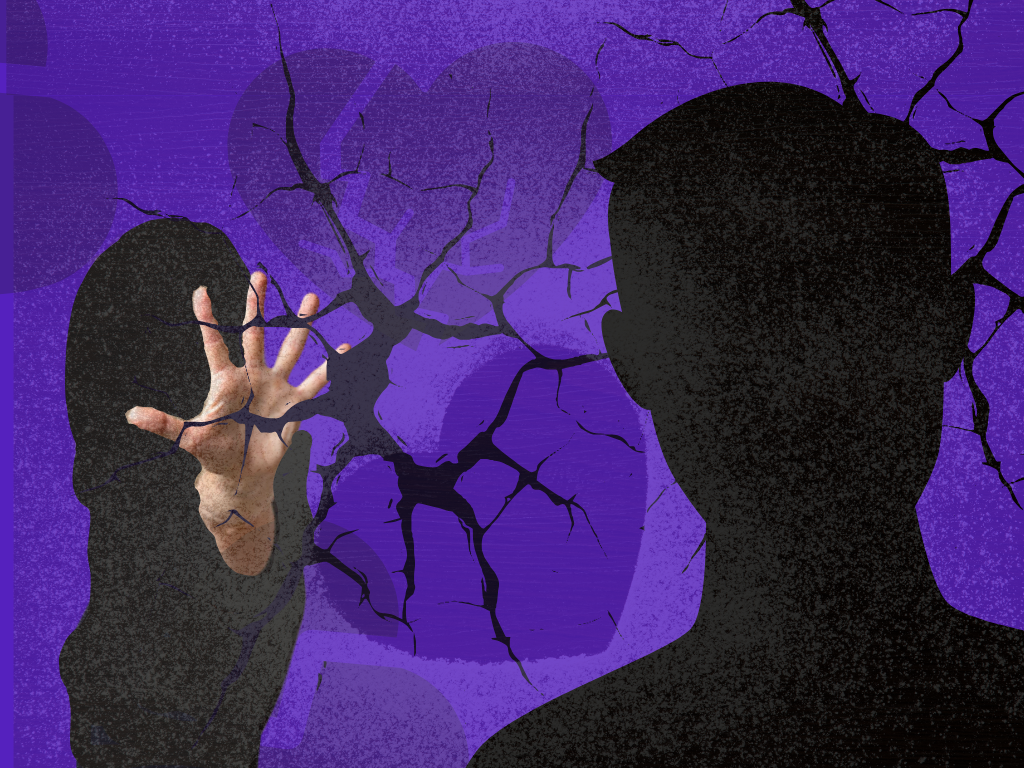
Image: SFD Media LLC
⚠️ Content Warning: This essay discusses intimate partner violence, emotional abuse, and trauma, including suicidal ideation. Please take care while reading.
He’d kick me in the leg if I said or did something he didn’t like, just a little “put-me-in-my-place” whack, I suppose. That’s how it started. I was a college student, dating my now ex-husband. I told a friend about it on a walk recently, demonstrating with a laugh.
A trauma laugh. I’d done the same in therapy the day before, picturing a ragdoll being booted down the road.
“If your daughter said her boyfriend kicked her,” my therapist inquired, “how would you respond?”
“I’d kill him,” I said without hesitation. Metaphorically, of course.
Holes rage-punched during arguments riddled our first apartment’s walls. Years later, he threw a chair through a window, burned our wedding photo album in front of our young kids as they begged him to stop, and threatened to paint WHORE on the side of the house while I pleaded for him to stop, his eyes prancing, feral. To the world, we were an adorable couple, so in love.
“I dare you!” I’d yell back when he threatened to hit me, my back against the wall, his fist in my face. “At least I’ll have bruises to prove it,” I’d shouted, far bolder on the outside than my neurons felt, as they seared the event into my brain. That image still comes to me in flashbacks. Twenty years hence, I can feel the anxiety rising in my chest as I write.
My therapist tells me to notice the differences in my response to my own experience versus someone I loved. Am I okay with my daughter experiencing items thrown? Computers smashed? Oh, hell no.
If she so much as hinted that a boyfriend did any of what my ex did, I’d move in to keep them company. One thing I’d sure as hell never say is, “What did you do to set him off?”
But in my youthful naivete, I rationalized, minimized, reframed. I thought I could change him—or God would. I prayed, bought him self-help books, went to Bible studies, and became who I thought he wanted as a wife. Nothing was ever good enough.
The Intimate Partner Violence We Rationalize
It’s taken years of therapy to excavate the damage those 13 years caused—or even to label it intimate partner violence (IPV), defined as physical, sexual, and psychological violence, coercion, and stalking.
Many women, especially older generations, never call what they experienced abuse. And many never get the mental health support needed to heal.
This generational silence is not accidental. “Fifty years ago, there were no services for victims of IPV or sexual assault,” since women were basically property, said Sandra Bloom, Drexel University associate professor of public health.
Decades Later, the Damage Remains: The Long Term Damage of IPV
“The data on older women indicate that few, maybe 1 percent, report recent experiences of intimate partner violence [IPV]. However, about 50 percent have experienced IPV in their lifetime [when you include stalking], with many of these women first experiencing it in adolescence or young adulthood,” said Anita Raj, a professor of public health at Tulane University who studies its impacts on women and marginalized groups. “Those early-in-life experiences have long-term mental health consequences.”
Many, including myself, developed post-traumatic stress disorder (PTSD), something often connected with soldiers returning from war. In this case, the person who promised to be a refuge from life’s storms becomes the thunder and unpredictable lightning.
“Women who have experienced IPV in their lifetime are 50 percent more likely to report severe depression and anxiety,” said Raj.
Check, and check.
Women who’ve had even one IPV experience also have greater odds of reporting suicidal thoughts and attempts than non-abused women. Suicidal thoughts ultimately led me to leave; my kids needed their mom.
Why We Stay: The Power of the Trauma Bond
“I never felt afraid of him,” I told my therapist. I turned the anger inward, blaming myself, as he did. Despite his rage, threats, and guns, he never physically beat me up, I told myself. (My therapist says this is “minimizing” and it is: Abuse almost always escalates.)
“He was like a teddy bear.” As we’d cuddle in bed at night, he’d gently touch each of the three freckles by my left eye, call me his Winnie Pooh-Bear, then kiss my eyelids.
I loved him fiercely. I still do.
“Folks need to realize that there [can be] a deep and profound love in these relationships,” said Alice*, a retired marketing professional and IPV survivor. “When he was good, he was the best. The bad parts were cyclical and usually far apart.”
“There’s a false perception of abusers as generally angry,” wrote Rachel Louise Snyder in No Visible Bruises. My ex exuded calm; when his anger popped up unannounced, inevitably in private, I danced with a raging animal. He was at war, and the enemy was me. I had to figure out how to keep the kids safe while keeping him from destroying things. My safety came last.
Hello, cognitive dissonance—the ability to hold conflicting beliefs at the same time. When we can’t bring ourselves to fear the person we love, my therapist told me, we may project our fear onto another object. Studies bear this out. Is it a coincidence I’m terrified of lightning—and almost nothing else?
In his groundbreaking book, The Body Keeps the Score, psychiatrist Bessel Van der Kolk, who studied PTSD for 20 years, discusses how bodies cope with trauma, including some surprises: “Terror increases the need for attachment even if the source of comfort is also the source,” he wrote.
This cognitive dissonance can lead many strong women to stay in unhealthy relationships, especially those who experienced childhood trauma, which primes a person to unwittingly feel at home with the rush of fear hormones.
How IPV Wreaks Havoc on the Body and Mind
Experiencing relationship abuse can also have physical manifestations, including chronic pain, sleep disorders, hypertension, gastrointestinal issues, and decreased cognitive functioning later in life.
There’s a science to what trauma does to the body.
Experiencing intimate partner violence activates the body’s hypothalamic-pituitary-adrenal (HPA) axis, part of the endocrine system that sends cortisol and adrenaline, among other hormones, surging through our bodies. When this occurs regularly, the mind tunes out or softens their hard edge.
It doesn’t end when the relationship does.
“I lived for decades on the HPA stress axis … in a near constant state of flight, fight, freeze, and fawn,” said Natasha*, who divorced and remarried the same man before moving out of state. “I was diagnosed in 2023 with breast cancer, and had … early onset shingles,” which her doctors connected to her experiences.
Over time, we may disconnect from our bodies.
“Victims of trauma dissociate, numbing their body to physical sensations,” wrote Tara Brach in her book, Radical Acceptance. Even after we’ve left the relationship, seemingly non-threatening experiences may activate what our bodies stored.
The past gets triggered in the present.
“[Someone] might raise their voice in frustration and the full force of our past wounds, all the terror or rage or hurt that lives in our body, can be unleashed,” Brach added. “Whether or not there is any actual danger, we feel absolutely at risk and compelled to get away from this pain.”
Minimizing and maximizing gone haywire.
People tend to respond to normal relationship conflict (as opposed to the fight, flight, freeze, and fawn response to IPV) in two main ways: Shrink oneself or expand oneself. Relationship expert Harville Hendrix calls the minimizer “the turtle,” and the maximizer “the hailstorm.” Opposites inevitably attract.
Minimizing can involve avoiding discussions or isolating from our partner, while maximizing can involve shouting back, or sobbing. But when someone experienced earlier-in-life trauma, these reactions can become outsized and unhealthy.
Affected by the past, shrinking or minimizing can take the form of silencing our own opinions, eating disorders, or numbing feelings with drugs or other addictions. On the other side, maximizing can become binging on food or shopping, pouring ourselves into work, or rage. Either way, our unhealed trauma can lead to difficulties trusting new partners and building healthy new relationships. It may even cause conflicts with friends.
This is more than personal—it’s political.
While relationship violence continues to be a major public health issue, Bloom credits the Women’s Liberation Movement for the rights and services we have today. “Without the internet or cell phones or computers, women organized,” she said. “Thousands of people showed up for marches … As a result, laws have been changed, hotlines developed, a shelter system is in place, Protection From Abuse laws [passed.]”
Progress isn’t accidental. It was demanded.
Women’s Services Are Still Under Threat
In the past few years, women’s rights have been rolled back. More recently, research on gender-based violence has lost federal funding, and some victim’s services are at risk of federal budget cuts (some was restored after bipartisan outrage) not to mention healthcare including mental health services, for lower-income individuals—like me.
This New York Times opinion piece explains, much of that support is still precarious.
Reconnecting: Somatic Therapy and the Path to Healing
Despite all this, there is hope and healing. My current therapist specializes in somatic therapy, which is having a moment. It’s especially helpful for people with PTSD, including IPV survivors. You learn to put awareness on how your body feels physically, not just pain points. What does your hand feel like in the air? Are you aware of how your legs feel on the chair?
Somatic therapy—which can include breath work, yoga, or “shaking” to relieve stored tension—aims to help people become embodied, or “in your body” more. This can bring greater enjoyment of life’s simple pleasures and may even dissolve tension in body parts with stored pain—particularly the neck, heart, or stomach—“areas in our body where fear expresses itself most distinctly,” wrote Brach.
Somatic therapy has given me more glimmers, joyful moments that relax the nervous system. Walking toward the California sunset the other day, the glow in my eyes became a physical sensation of pleasure, merging into a hopeful feeling as I thought of the three generations of my maternal lineage and how we broke free from bad situations.
With intimate partner violence, there’s no his and her sides (or her and her, though men comprise the vast majority of perpetrators.) You’d be hard-pressed to convince anyone that society should tolerate violence against a woman. The distinction is how society tolerates us defining violence, and how this affects our rights; it’s in the empathy given to survivors versus perpetrators (think Amber Heard vs. Johnny Depp, a trial televised without her permission); it’s in how far society will go to protect women, including older women, who still need therapeutic and familial support to find our peace, decades later.
The emotional scars will never fully leave our bodies or our minds. But we can reclaim our power by telling our stories. This is the first time I’ve told mine.
*Identifying details have been changed to protect privacy.
If you or someone you know is experiencing relationship abuse, here are resources that may help—it’s never too late to reclaim your peace.
As the Mayo Clinic says, “Anyone who feels threatened, vulnerable, or scared in a relationship needs help.” Contact the National Domestic Violence Hotline at 1-800-799-SAFE (7233).
The Center for Relationship Abuse Awareness
https://stoprelationshipabuse.org/
Domestic Shelters’ Resource Page
https://www.domesticshelters.org/
Reading List for Survivors of Domestic Violence
https://www.domesticshelters.org/resources/books/becoming-a-survivor
The U.S. Association for Body Psychotherapy


0 Comments